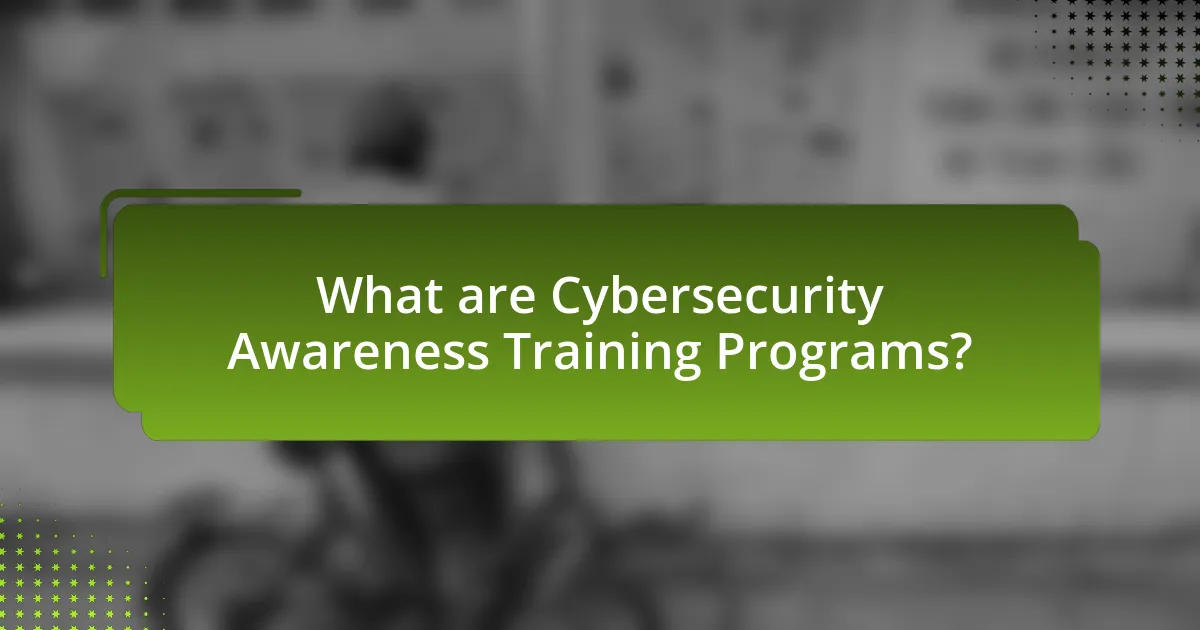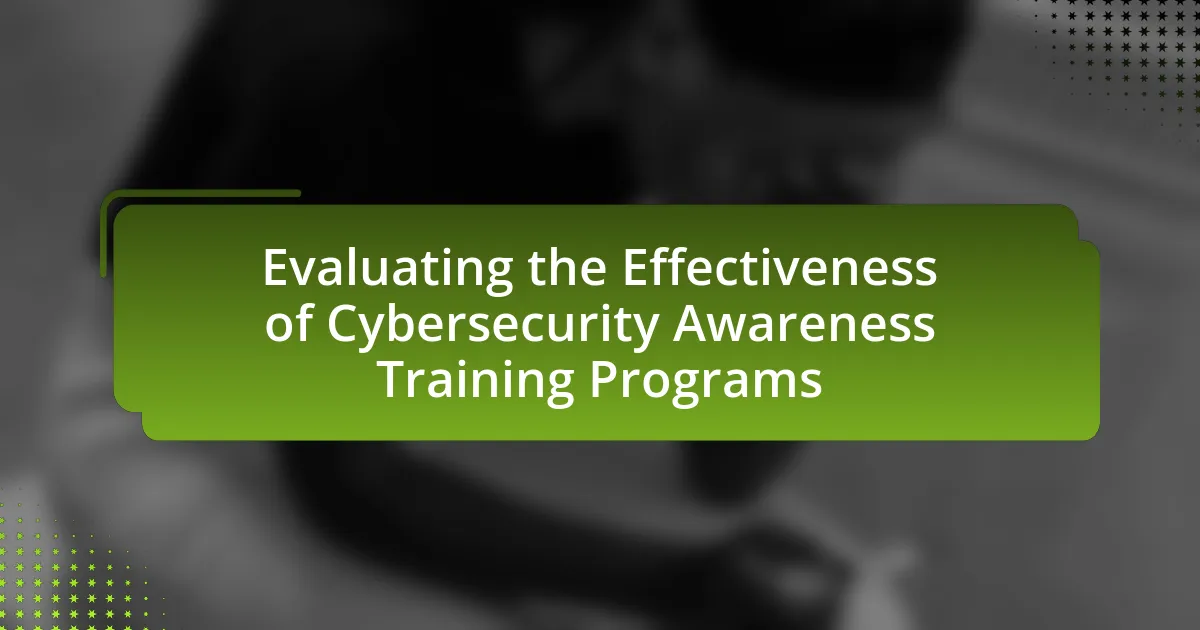Cybersecurity Awareness Training Programs are structured initiatives aimed at enhancing employees’ understanding of cybersecurity risks and best practices to mitigate security breaches. The article evaluates the effectiveness of these programs, highlighting their importance in reducing human error-related incidents, which account for up to 90% of successful cyberattacks. Key components of effective training include engaging content, regular updates, practical exercises, and assessment mechanisms. The article also discusses the challenges in evaluating these programs, the significance of ongoing training, and best practices for tailoring content to meet organizational needs, ultimately emphasizing the role of employee behavior changes in improving cybersecurity resilience.

What are Cybersecurity Awareness Training Programs?
Cybersecurity Awareness Training Programs are structured educational initiatives designed to enhance employees’ understanding of cybersecurity risks and best practices. These programs aim to reduce the likelihood of security breaches by equipping participants with knowledge about threats such as phishing, malware, and social engineering. Research indicates that organizations implementing such training can reduce the risk of security incidents by up to 70%, demonstrating their effectiveness in fostering a security-conscious culture.
Why are Cybersecurity Awareness Training Programs important?
Cybersecurity Awareness Training Programs are important because they significantly reduce the risk of security breaches caused by human error. Research indicates that up to 90% of successful cyberattacks exploit human vulnerabilities, such as phishing and social engineering tactics. By educating employees on recognizing threats and implementing safe practices, organizations can enhance their overall security posture. A study by the Ponemon Institute found that organizations with comprehensive training programs experienced 70% fewer security incidents compared to those without such initiatives. This demonstrates that effective training not only raises awareness but also leads to measurable improvements in cybersecurity resilience.
What risks do organizations face without these training programs?
Organizations face significant risks without cybersecurity awareness training programs, including increased vulnerability to cyberattacks, data breaches, and financial losses. Without proper training, employees may lack the knowledge to recognize phishing attempts or other malicious activities, leading to higher rates of successful attacks. For instance, a report by the Ponemon Institute found that organizations with comprehensive security awareness training experienced 70% fewer successful phishing attacks compared to those without such programs. Additionally, the absence of training can result in non-compliance with regulations, leading to legal penalties and reputational damage. Overall, the lack of training exposes organizations to a heightened risk landscape, making them attractive targets for cybercriminals.
How do these programs contribute to overall cybersecurity posture?
Cybersecurity awareness training programs enhance overall cybersecurity posture by equipping employees with the knowledge and skills to recognize and respond to security threats. These programs reduce the likelihood of human error, which is a significant factor in data breaches; for instance, studies indicate that up to 90% of successful cyberattacks exploit human vulnerabilities. By fostering a culture of security awareness, organizations can significantly lower their risk profile and improve incident response times, ultimately leading to a more resilient cybersecurity framework.
What are the key components of effective Cybersecurity Awareness Training Programs?
Effective Cybersecurity Awareness Training Programs consist of several key components: engaging content, regular updates, practical exercises, and assessment mechanisms. Engaging content ensures that participants remain interested and can relate to real-world scenarios, which is crucial for retention. Regular updates are necessary to keep the training relevant, as cyber threats evolve rapidly; for instance, the 2021 Verizon Data Breach Investigations Report highlighted that 85% of breaches involved human elements, underscoring the need for continuous learning. Practical exercises, such as phishing simulations, allow participants to apply their knowledge in a controlled environment, reinforcing learning through experience. Lastly, assessment mechanisms, including quizzes and feedback surveys, measure the effectiveness of the training and identify areas for improvement, ensuring that the program adapts to the needs of the organization and its employees.
What topics should be covered in these training programs?
Training programs should cover topics such as phishing awareness, password security, data protection, social engineering tactics, and incident reporting procedures. These subjects are essential because they equip participants with the knowledge to recognize and respond to cybersecurity threats effectively. For instance, studies show that organizations with comprehensive phishing training can reduce susceptibility to such attacks by up to 70%. Additionally, understanding password security can prevent unauthorized access, as weak passwords are a leading cause of data breaches. By addressing these critical areas, training programs can significantly enhance overall cybersecurity awareness and resilience within organizations.
How can training methods impact the effectiveness of the programs?
Training methods significantly impact the effectiveness of cybersecurity awareness training programs by influencing participant engagement, retention of information, and behavioral change. For instance, interactive training methods, such as simulations and hands-on exercises, have been shown to enhance learning outcomes compared to traditional lecture-based approaches. A study by the National Cyber Security Centre found that participants who engaged in interactive training retained 60% more information than those who received passive instruction. Furthermore, training methods that incorporate real-world scenarios and gamification can lead to a 70% increase in the likelihood of employees applying learned behaviors in their daily tasks. These findings underscore the importance of selecting appropriate training methods to maximize the effectiveness of cybersecurity awareness initiatives.

How can we evaluate the effectiveness of Cybersecurity Awareness Training Programs?
To evaluate the effectiveness of Cybersecurity Awareness Training Programs, organizations can utilize pre- and post-training assessments to measure knowledge retention and behavioral changes. These assessments often include quizzes, surveys, and simulated phishing attacks to gauge participants’ understanding of cybersecurity principles and their ability to recognize threats. Research indicates that organizations employing such evaluations see a 70% reduction in successful phishing attacks, demonstrating the tangible impact of effective training. Additionally, tracking incident reports and employee feedback over time can provide further insights into the program’s success and areas for improvement.
What metrics can be used to assess the effectiveness of these programs?
Metrics used to assess the effectiveness of cybersecurity awareness training programs include knowledge retention rates, behavior change assessments, phishing simulation results, and incident reporting rates. Knowledge retention rates measure how much information participants remember post-training, often evaluated through quizzes or assessments. Behavior change assessments track the application of learned skills in real-world scenarios, indicating whether employees are applying their training. Phishing simulation results gauge the susceptibility of employees to phishing attacks before and after training, providing a clear metric of improvement. Incident reporting rates reflect the increase in employees reporting suspicious activities, demonstrating heightened awareness and vigilance. These metrics collectively provide a comprehensive view of the training program’s impact on employee behavior and organizational security posture.
How do pre- and post-training assessments measure knowledge retention?
Pre- and post-training assessments measure knowledge retention by evaluating participants’ understanding before and after training sessions. These assessments typically consist of quizzes or tests that gauge the baseline knowledge of participants prior to training and then reassess their knowledge after the training has been completed. The difference in scores between the pre- and post-assessments indicates the extent of knowledge gained and retained. For example, a study published in the Journal of Cybersecurity Education, Research and Practice found that participants who scored an average of 40% on pre-training assessments improved to an average of 85% on post-training assessments, demonstrating significant knowledge retention.
What role do employee behavior changes play in evaluation?
Employee behavior changes are critical in evaluating the effectiveness of cybersecurity awareness training programs. These changes indicate whether employees have internalized the training content and are applying it in their daily work practices. For instance, a study by the Ponemon Institute found that organizations with effective cybersecurity training saw a 70% reduction in security incidents attributed to human error, demonstrating a direct correlation between behavior change and improved security outcomes. Thus, monitoring these behavior changes provides measurable evidence of the training program’s success and areas needing improvement.
What challenges exist in evaluating Cybersecurity Awareness Training Programs?
Evaluating Cybersecurity Awareness Training Programs presents several challenges, including measuring behavioral change, ensuring consistent engagement, and assessing long-term retention of knowledge. Behavioral change is difficult to quantify, as it requires tracking incidents of security breaches or risky behaviors before and after training, which can be influenced by various external factors. Consistent engagement is another challenge, as employees may not fully participate in training sessions or may forget key concepts over time. Additionally, assessing long-term retention is complicated by the fact that knowledge can degrade without regular reinforcement, making it hard to determine the lasting impact of the training. These challenges highlight the complexities involved in accurately evaluating the effectiveness of such programs.
How can organizations overcome resistance to training?
Organizations can overcome resistance to training by actively involving employees in the training design process and clearly communicating the benefits of the training. Engaging employees in the development of training programs fosters a sense of ownership and relevance, which can significantly reduce resistance. Research indicates that when employees perceive training as beneficial to their personal and professional growth, their willingness to participate increases. For instance, a study published in the Journal of Workplace Learning found that organizations that included employee feedback in training design saw a 30% increase in participation rates. Additionally, providing incentives and recognizing achievements related to training can further motivate employees to embrace training initiatives.
What limitations do traditional evaluation methods have?
Traditional evaluation methods for cybersecurity awareness training programs have several limitations, primarily their inability to accurately measure behavioral change and long-term retention of knowledge. These methods often rely on pre- and post-training assessments, which may not reflect real-world application or the retention of skills over time. Research indicates that such assessments can lead to a false sense of security, as they do not account for the dynamic nature of cybersecurity threats or the varying contexts in which knowledge is applied. Additionally, traditional methods may overlook the influence of organizational culture and individual differences in learning styles, which can significantly impact the effectiveness of training.

What best practices can enhance the effectiveness of Cybersecurity Awareness Training Programs?
To enhance the effectiveness of Cybersecurity Awareness Training Programs, organizations should implement interactive and engaging training methods. Research indicates that interactive training methods, such as simulations and gamification, significantly improve retention rates and user engagement, leading to better understanding of cybersecurity threats. For instance, a study by the Ponemon Institute found that organizations using gamified training saw a 48% increase in employee engagement compared to traditional methods. Additionally, tailoring content to specific roles within the organization ensures relevance, as employees are more likely to relate to scenarios that reflect their daily tasks. Regular updates to training materials, based on emerging threats, also keep the content fresh and applicable, further enhancing effectiveness.
How can organizations tailor training to meet specific needs?
Organizations can tailor training to meet specific needs by conducting a thorough needs assessment to identify gaps in knowledge and skills among employees. This assessment can include surveys, interviews, and performance evaluations to gather data on specific areas where training is required. For instance, a study by the National Institute of Standards and Technology (NIST) emphasizes the importance of customizing training content based on the unique risks and challenges faced by an organization, which can enhance the relevance and effectiveness of the training. By aligning training objectives with organizational goals and employee roles, organizations can ensure that the training is directly applicable and beneficial, ultimately leading to improved cybersecurity awareness and behavior among staff.
What role does ongoing training play in maintaining awareness?
Ongoing training plays a crucial role in maintaining awareness by continuously updating individuals on the latest cybersecurity threats and best practices. This regular engagement helps reinforce knowledge, ensuring that employees remain vigilant against evolving risks. Research indicates that organizations implementing ongoing training programs experience a 70% reduction in security incidents, demonstrating the effectiveness of sustained education in fostering a culture of awareness.
How can feedback be effectively incorporated into training programs?
Feedback can be effectively incorporated into training programs by establishing a structured process for collecting, analyzing, and implementing participant input. This process involves soliciting feedback through surveys, interviews, and assessments immediately after training sessions, which allows for timely insights into the training’s effectiveness. Research indicates that organizations that actively seek participant feedback can improve training outcomes by up to 30%, as highlighted in a study by the Association for Talent Development. Additionally, integrating feedback loops into the training design ensures continuous improvement, allowing trainers to adapt content and delivery methods based on real-time participant experiences. This approach not only enhances engagement but also aligns training objectives with learner needs, ultimately leading to more effective cybersecurity awareness training programs.
What are common pitfalls to avoid in Cybersecurity Awareness Training Programs?
Common pitfalls to avoid in Cybersecurity Awareness Training Programs include lack of engagement, insufficient frequency of training, and failure to tailor content to the audience. Lack of engagement can lead to low retention rates, as studies show that interactive and engaging training methods improve knowledge retention by up to 60%. Insufficient frequency of training can result in outdated knowledge, as cybersecurity threats evolve rapidly; organizations should aim for regular updates and refreshers. Additionally, failing to tailor content to the specific roles and responsibilities of employees can diminish the relevance of the training, as research indicates that personalized training increases effectiveness by 50%.
How can organizations ensure training is engaging and relevant?
Organizations can ensure training is engaging and relevant by incorporating interactive elements, real-world scenarios, and personalized content tailored to the specific needs of employees. Research indicates that interactive training methods, such as simulations and gamification, significantly enhance learner engagement and retention rates. For instance, a study published in the Journal of Cybersecurity Education, Research and Practice found that participants in gamified training programs demonstrated a 30% increase in knowledge retention compared to traditional methods. Additionally, aligning training content with the actual cybersecurity threats faced by the organization ensures that employees find the material applicable and valuable, thereby increasing their motivation to participate actively in the training.
What mistakes can undermine the credibility of the training?
Mistakes that can undermine the credibility of cybersecurity awareness training include using outdated information, failing to tailor content to the audience, and neglecting to provide practical, real-world scenarios. Outdated information can mislead participants, as cybersecurity threats evolve rapidly; for instance, a 2021 report by Cybersecurity Ventures indicated that cybercrime costs are projected to reach $10.5 trillion annually by 2025, highlighting the need for current training materials. Failing to tailor content can result in disengagement, as training that does not resonate with the specific roles or experiences of participants is less effective. Additionally, neglecting practical scenarios can lead to a lack of preparedness; research from the Ponemon Institute shows that organizations with hands-on training experience a 70% reduction in security incidents. These mistakes collectively diminish the perceived value and effectiveness of the training program.
What practical tips can organizations implement for effective Cybersecurity Awareness Training?
Organizations can implement several practical tips for effective Cybersecurity Awareness Training, including regular training sessions, interactive content, and real-world simulations. Regular training sessions ensure that employees stay updated on the latest threats and best practices, as research indicates that continuous education significantly reduces the likelihood of security breaches. Interactive content, such as quizzes and gamified learning, enhances engagement and retention of information, making it more likely that employees will apply what they learn. Real-world simulations, like phishing tests, provide employees with hands-on experience in identifying and responding to threats, which has been shown to improve their ability to recognize and mitigate risks in actual scenarios.



